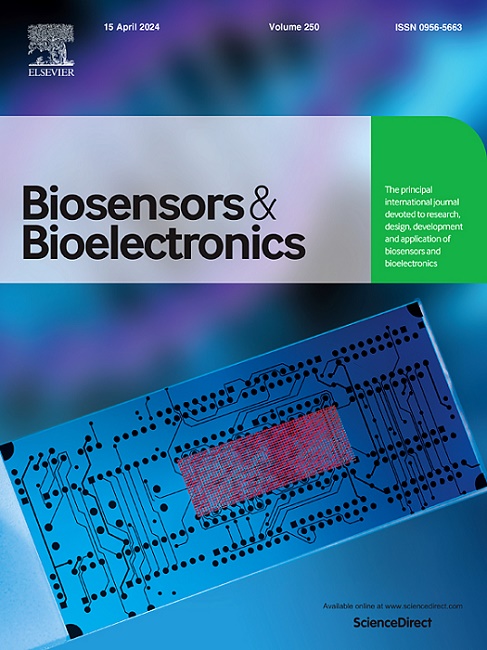Magnetically controlled all-in-one sensing platform for triple-mode detection of organophosphorus pesticides using DNA tetrahedrons-polydopamine reporters
IF 10.7
1区 生物学
Q1 BIOPHYSICS
引用次数: 0
Abstract
Accurate and on-site detection of organophosphorus pesticides (OPs) in complex matrixes is important for environmental monitoring and food safety. Herein, a colorimetric (CL), photothermal (PT) and fluorescence (FL) triple-mode sensor was constructed for OPs detection based on magnetically controlled all-in-one platform, which was featured of specific recognition unit, abundant loading of DNA tetrahedrons-Fe3+-polydopamine (TDN-Fe3+-PDA) with peroxidase-like activity, and verifiable triple-mode signal output. Based on the aptamer-target recognition and efficient separation of MBs, large amount of TDN-Fe3+-PDA reporters was released. Taking full advantages of the supernatant and precipitation, OPs was sensitively detected with the TDN-Fe3+-PDA catalyzed 3,3′,5,5′-tetramethylbenzidine (TMB)-H2O2 system (CL mode), photothermal effect of TDN-Fe3+-PDA and oxidized TMB (oxTMB) (PT mode), and fluorescent signal of TDN-templated copper nanoclusters on MBs (FL mode). Using profenofos (Pro) as the model target, the triple-mode sensing platform realized sensitive detection of Pro with the detection limits 0.23 ng/mL, 0.40 ng/mL and 0.14 ng/mL for CL, PT and FL mode, respectively. The proposed strategy provided a simple and accurate method for on-site detection of OPs, holding promising application in environmental and food contamination monitoring.
求助全文
约1分钟内获得全文
求助全文
来源期刊

Biosensors and Bioelectronics
工程技术-电化学
CiteScore
20.80
自引率
7.10%
发文量
1006
审稿时长
29 days
期刊介绍:
Biosensors & Bioelectronics, along with its open access companion journal Biosensors & Bioelectronics: X, is the leading international publication in the field of biosensors and bioelectronics. It covers research, design, development, and application of biosensors, which are analytical devices incorporating biological materials with physicochemical transducers. These devices, including sensors, DNA chips, electronic noses, and lab-on-a-chip, produce digital signals proportional to specific analytes. Examples include immunosensors and enzyme-based biosensors, applied in various fields such as medicine, environmental monitoring, and food industry. The journal also focuses on molecular and supramolecular structures for enhancing device performance.
 求助内容:
求助内容: 应助结果提醒方式:
应助结果提醒方式:


